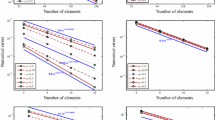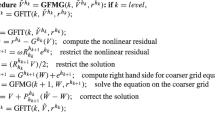Abstract
The method presented in Aubry et al. (Comput Struc 83:1459–1475, 2005) for the solution of an incompressible viscous fluid flow with heat transfer using a fully Lagrangian description of motion is extended to three dimensions (3D) with particular emphasis on mass conservation. A modified fractional step (FS) based on the pressure Schur complement (Turek 1999), and related to the class of algebraic splittings Quarteroni et al. (Comput Methods Appl Mech Eng 188:505–526, 2000), is used and a new advantage of the splittings of the equations compared with the classical FS is highlighted for free surface problems. The temperature is semi-coupled with the displacement, which is the main variable in a Lagrangian description. Comparisons for various mesh Reynolds numbers are performed with the classical FS, an algebraic splitting and a monolithic solution, in order to illustrate the behaviour of the Uzawa operator and the mass conservation. As the classical fractional step is equivalent to one iteration of the Uzawa algorithm performed with a standard Laplacian as a preconditioner, it will behave well only in a Reynold mesh number domain where the preconditioner is efficient. Numerical results are provided to assess the superiority of the modified algebraic splitting to the classical FS.
Similar content being viewed by others
References
Arnold DN, Brezzi F, Fortin M (1984) A stable finite element for the Stokes equations. Calcolo 21(4):337–344
Arrow K, Hurwicz L, Uzawa H (1958) Studies in linear and nonlinear programming. Stanford University Press, Stanford
Ashby SF, Manteuffel TA, Saylor PE (1990) A taxonomy for conjugate gradient methods. SIAM J Numer Anal 27(6):1542–1568
Aubry R (2006) Incompressible Lagrangian fluid flow with thermal coupling. PhD thesis, Universidad Politécnica de Catalunya
Aubry R, Idelsohn SR, Oñate E (2005) Particle finite element method in fluid mechanics including thermal convection-diffusion. Comput Struc 83:1459–1475
Axelsson O, Barker VA (2001) Finite element solution of boundary value problems. Classics in applied mathematics. SIAM, Philadelphia
Baiocchi C, Brezzi F, Franca LP (1993) Virtual bubbles and the Galerkin-least-squares methods. Comput Methods Appl Mech Eng 105:125–141
Bank RE, Welfert BD (1990) A comparison between the mini element and the Petrov-Galerkin formulations for the generalized Stokes problem. Comput Methods Appl Mech Eng 83:61–68
Belytschko T, Liu WK, Moran B (2000) Nonlinear finite elements for continua and structures. Wiley, New York
Benzi M, Tuma M (2003) A robust incomplete factorization preconditioner for positive definite matrices. Numer Linear Algebra Appl 10:385–400
Benzi M, Tuma M (2003) A robust preconditioner with low memory requirements for large sparse least square problems. Siam J Sci Comput 25(2):499–512
Benzi M, Golub GH, Liesen J (2005) Numerical solution of saddle point problems. Acta Numerica 14:1–137
Bertrand F, Tanguy PA (2002) Krylov-based Uzawa algorithms for the solution of the Stokes equations using discontinuous-pressure tetrahedral finite elements. J Comput Phys 181(2):617–638
Bertrand F, Gadbois M, Tanguy PA (1992) Tetrahedral elements for fluid flow problems. Int J Numer Methods Eng 33:1251–1267
Blair Perot J (1993) An analysis of the fractional step method. J Comput Phys 108(1):51–58
Bollhöfer M (2001) A robust ILU with pivoting based on monitoring the growth of the inverse factors. Linear Algebra Appl 338:201–218
Bramble JH, Pasciak JE (1997) Iterative techniques for time dependent Stokes problems. Comput Math Appl 33:13–30
Brezzi F, Fortin M (1991) Mixed and hybrid finite element methods. Springer, Berlin Heidelberg New York
Cahouet J, Chabard JP (1988) Some fast 3D finite element solvers for the generalized Stokes problem. Int J Numer Methods Fluids 8:869–895
Chorin AJ (1968) Numerical solution of the Navier–Stokes equations. Math Comp 22:745–762
Ciarlet PG, Raviart PA (1973) Maximum principle and uniform convergence for the finite element method. Comput Methods Appl Mech Eng 2:17–31
Codina R (2000) Pressure stability in fractional step finite element methods for incompressible flows. J Comput Phys 190:1579–1599
Crank J, Nicolson P (1947) A practical method for numerical evaluation of solutions of partial differential equations of the heat conduction type. Proc Camb Phil Soc 43:50–64
Crouzeix M, Raviart PA (1973) Conforming and nonconforming finite element methods for solving the stationary Stokes equations. RAIRO Analyse Numérique, pp 33–76
Dean EJ, Glowinski R (1993). On some finite element methods for the numerical simulation of incompressible viscous flow. In: Gunzburger MD, Nicolaides RA (eds). Incompressible computational fluid dynamics. Cambridge University Press, Cambridge, pp 17–65
Del Pin F, Idelsohn SR, Oñate E, Aubry R (2005) The ALE/Lagrangian Particle Finite Element Method: a new approach to computation of free-surface flows and fluid-object interactions. Comput Fluids (in press)
Edelsbrunner H, Mücke EP (1994) Three-dimensional alpha shapes. ACM Trans Graph 13(1):43–72
Eisenstat SC (1981) Efficient implementation of a class of preconditioned conjugate gradient methods. SIAM J Sci Stat Comput 2:1–4
Elman HC, Silvester DJ, Wathen AJ (2005) Finite elements and fast iterative solvers. Oxford University Press, New York
Franca LP, Farhat C (1995) Bubble functions prompt unusual stabilized finite element methods. Comput Methods Appl Mech Eng 123:299–308
Frey PJ, George PL (1999) Maillages, applications aux elements finis. Hermes, Paris
George PL ed. (2001) Maillage et adaptation. Lavoisier, Paris (in French)
Girault V, Raviart PA (1986) Finite element methods for Navier-Stokes equation. Springer, Berlin Heidelberg New York
Gresho PM, Lee RL, Sani RL (1984) Further studies on equal-order interpolation for Navier-Stokes. In: Proceedings of the 5th international symposium on finite elements in flow problems. Austin, Texas
Henriksen M, Holmen J (2002) Algebraic splitting for Navier-Stokes equations. J Comput Phys 175:438–453
Hirt CW, Nichols BD (1981) Volume of fluid (VOF) method for the dynamics of free boundaries. J Comput Phys 39:201–225
Hughes TJR (2000) The Finite element method, linear static and dynamic finite element analysis. Dover Publishers, New York
Hughes TJR, Mallet M (1986) A new finite element formulation for computational fluid dynamics: IV. A discontinuity-capturing operator for multidimensional advective-diffusive systems. Comput Methods Appl Mech Eng 58:329–339
Idelsohn SR, Oñate E, Del Pin F (2004) The Particle finite element method: a powerful tool to solve incompressible flows with free-surfaces and breaking waves. Int J Numer Methods Eng 61(7):964–989
Johnson AA, Tezduyar TE (1999) Advanced mesh generation and update methods for 3D flow simulations. Comput Mech 23:130–143
Löhner R (2001) Applied CFD Techniques. Wiley, New York
Löhner R (2004) Projective prediction of pressure increments. Comm Numer Methods Eng 21:201–207
Mardal KA, Winther R (2004) Uniform preconditioners for the time dependent Stokes problem. Numer Math 98(2):305–327
Mardal KA, Tai XC, Winther R (2002) A robust finite element method for Darcy-Stokes flow. SIAM J Numer Anal 40:1605–1631
Oñate E, Idelsohn SR, Del Pin F, Aubry R (2004) The particle finite element method: an overview. Int J Comput Methods 1(2):267–307
Osher S, Fedkiw RP (2002) Level set methods and dynamic implicit surfaces. Springer, Berlin Heidelberg New York
Page CC, Saunders MA (1975) Solution of sparse indefinite systems of linear equations. Siam J Numer Anal 12(4):617–629
Pelletier D, Fortin A, Camarero R (1989) Are FEM solutions of incompressible flows really incompressible? (or how simple flows can cause headaches!). Int J Numer Methods Fluids 9:99–112
Pichelin E, Coupez T (1999) A Taylor discontinuous Galerkin method for the thermal solution in 3d mold filling. Comput Methods Appl Mech Eng 178:153–169
Pierre R (1989) Regularization procedures of mixed finite element approximations of the Stokes problem. Numer Methods Part Diff Eq 5:241–258
Pierre R (1995) Optimal selection of the bubble function in the stabilization of the P1-P1 element for the Stokes problem. Numer Methods Part Diff Eq 32(4):1210–1224
Pierre R (1995) Simple C 0-approximations for the computations of incompressible flows. Comput Methods Appl Mech Eng 68:205–227
Prohl A (1997) Projection and Quasi–Compressibility Methods for solving the incompressible Navier–Stokes Equations. Teubner, Stuttgart
Quarteroni A, Saleri F, Veneziani A (2000) Factorization methods for the numerical approximation of Navier–Stokes equations. Comput Methods Appl Mech Eng 188:505–526
Roberts J, Thomas J (1991) Mixed and hybrid methods. In: Ciarlet P, Lions JL (eds) Handbook of numerical analysis, vol. 2. North-Holland, Amsterdam, pp 523–640
Saad Y (2003) Iterative methods for sparse linear systems. SIAM, 2nd edn. Philadelphia
Saleri F, Veneziani A (2005) Pressure correction algebraic splitting methods for the incompressible Navier–Stokes equations. SIAM J Numer Anal 43:174–194
Soulaimani A, Fortin M, Dhatt G, Ouellet Y, Bertrand F (1987) Simple continuous pressure elements for two- and three-dimensional incompressible flows. Comput Methods Appl Mech Eng 1:47–69
Strang G, Fix G (1973) An analysis of the finite element method. Wellesley-Cambridge Press, Wellesley
Témam R (1969) Sur l’approximation de la solution des équations de Navier–Stokes par la méthode des pas fractionnaires. Arch Rat Mech Anal 32:135–153
Tezduyar TE, Liou J, Ganjoo DJ (1990) Incompressible flow computations based on the vorticity-stream function and velocity-pressure formulations. Comput Struc 35:445–472
Thomée V (1984) Galerkin finite element methods for parabolic problems. Springer, Berlin Heidelberg New York
Thompson JF, Bharat S, Weatherill N (eds) (1999) Handbook of grid generation. CRC Press, West Palm Beach
Timmermans LJP, Minev PD, Van De Vosse FN (1996) An approximate projection scheme for incompressible flow using spectral elements. Int J Numer Methods Fluids 22:673–688
Turek S (1999) Efficient solvers for incompressible flow problems–an algorithmic and computational approach. Springer, Berlin Heidelberg New York
Verfürth R (1984) Error estimates for a mixed finite element approximation of the Stokes equations. RAIRO Anal Numer 18:175–182
Author information
Authors and Affiliations
Corresponding author
Rights and permissions
About this article
Cite this article
Aubry, R., Oñate, E. & Idelsohn, S.R. Fractional Step Like Schemes for Free Surface Problems with Thermal Coupling Using the Lagrangian PFEM. Comput Mech 38, 294–309 (2006). https://doi.org/10.1007/s00466-006-0058-5
Received:
Accepted:
Published:
Issue Date:
DOI: https://doi.org/10.1007/s00466-006-0058-5




